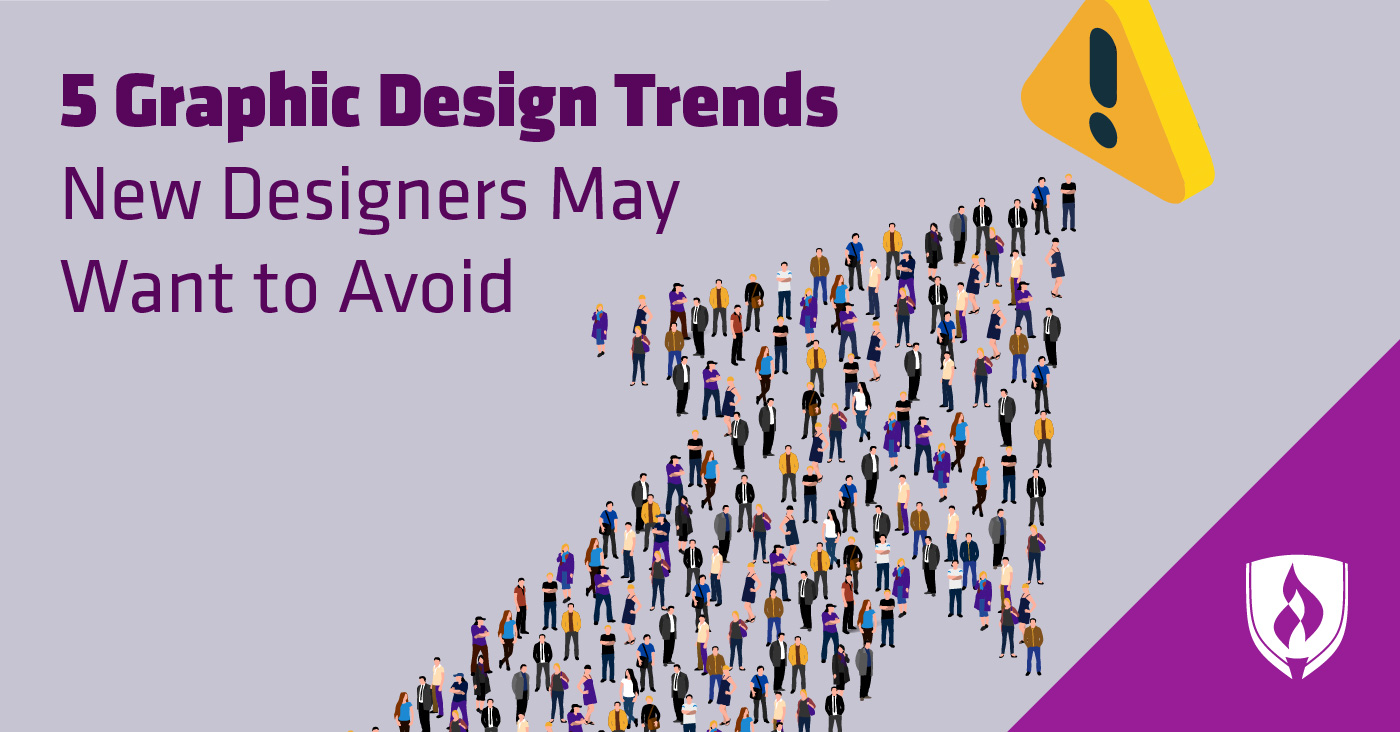
We have all made mistakes trying to fit in. Every decade is littered with people following trends and styles that are often met with a cringe in hindsight—whether it was bell-bottomed jeans or those swoopy banged emo haircuts. Fortunately, we can always adjust. But do those maybe-not-so-great trends happen in graphic design as well? Absolutely!
When you are starting out a career in graphic design, it can be hard to identify the trends experienced designers know to avoid. While you may be really proud of a new design, it might be the equivalent of going to the office in shoulder pads and a feathered 80s haircut—woefully outdated. So to help keep you out of that position, we’ve asked design pros to share some of the trends that are going out of style and other common blunders to avoid.
5 Graphic design trends you may want to think twice about
Before we get too far along, it’s important to note that while many of these graphic design trends are likely to be out of favor, design is still subjective. You can still make a compelling case for using some of these elements if they are part of a well-executed design—just be aware of the general feelings some may have about them.
1. Heavy use of gradients
Good graphic design thrives in simplicity—though gradients have been popular recently with big companies like Instagram and Tinder. That said, some designers are letting gradients and other overly-busy elements distract from the overall design.
“When fonts are large and bold, they should be balanced by the negative space around them,” says Taylor Morris, motion designer at Company Man Studios. “Soft gradients are great additions to add some depth to a design, but taking these techniques too far go against the simplicity that has recently been at the forefront of the graphic design industry.”
2. Relying too much on stock images
Many of our experts pointed to an overreliance on stock images as an easy way to identify rookie designers. The truth is, stock photography is a fact of life for graphic design professionals. Not every organization is going to have the budget or resources to capture professional quality photography for every project. The key is to be thoughtful about your choices and not going to the “happy smiling model” well too often in your work.
Seek out visual variety and photography that fits the desire for authenticity in design. When you do use stock photography for a design, remember not everyone needs to be an idealized model staring directly into the camera—seek out images that look natural and reflect their audience.
3. Helvetica
Helvetica is a classic font. There is even a documentary about the font commemorating the fiftieth anniversary of Helvetica’s creation. However, there can be a tendency to overuse the font among new designers.
“As much as I love Helvetica, there seems to be a tendency for inexperienced designers to overuse the typeface, especially for branding work,” says Jason Lawes, owner of Red Sentence. “With so many well-known brands making use of Helvetica it seems a shame not to explore the wide range of other fantastic typefaces available to us as designers.”
4. Muted colors
Simple designs are in, but so are vivid color schemes.
“My costumers are requesting lots of vivid colors in their branding and web design projects,” says Jessica Rhoades, owner and designer at Create IT Web Designs. “Muted, natural color schemes are going out of style. Costumers want their graphics to pop on the screen. They want to be bright and stand out from their competition.”
“The first big trend on its way out in 2020 would be the use of understated colors,” agrees Sanoj Mohan, senior team lead at Fingent. “Graphic designers all over are leaning more towards the use of bold and vivid colors in their designs these days. This is informed by the fact that the majority of costumers find the retro look with vivid colors more appealing.”
5. Complex designs
Creating overly complicated designs is a common pitfall for new designers. The opportunity to flex your creativity and newfound design skills is hard to pass up, but often the more complicated a design, the less experienced the designer.
“Simplicity and clarity in design is on the increase—complexity and multi-layered designs will be phased out more,” says Lawes. “In a world where time is precious, brands have a short window to stand out from the crowd with their marketing and advertising to grab potential costumer’s attention. This is best done through the use of simplicity and clarity. If you have to explain an idea, it doesn’t work. Important to note that just because it should be simple does not mean it should lack in creativity.”
Interested in other ways to grow as a graphic designer?
If you’re just getting started in the graphic design field, you might be wondering if it’s best to take a self-taught approach or if you should pursue some form of formal education. Start weighing your options in our article, “Is a Graphic Design Degree Worth It or Worthless?”




